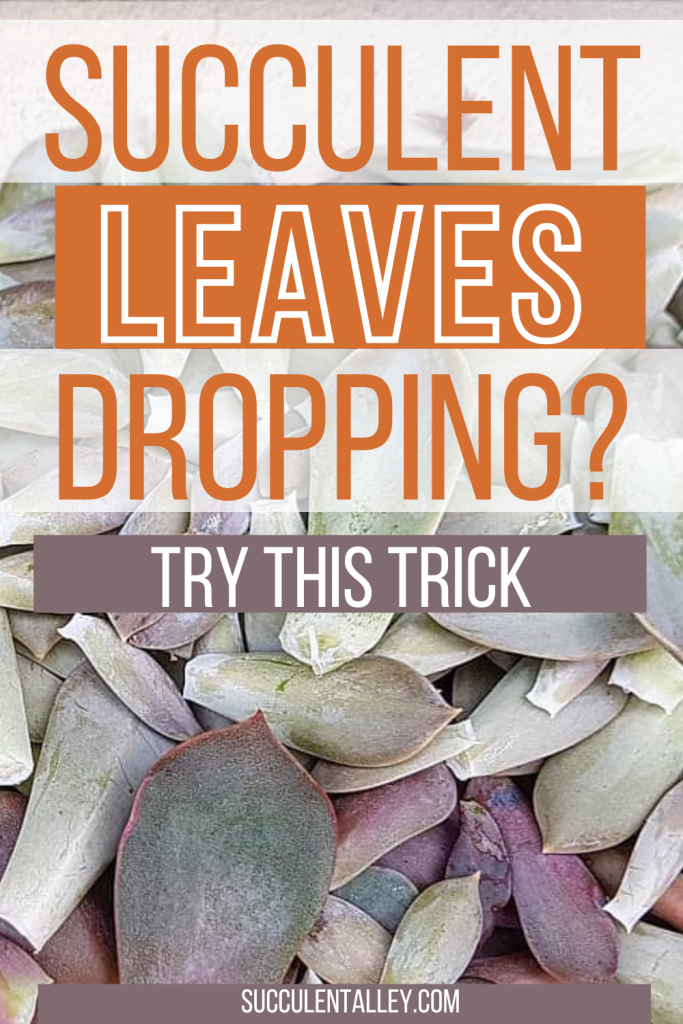Succulents Shedding Leaves? Here’s What You Need to Know
Succulents, with their plump leaves and low-maintenance reputation, are the darlings of the houseplant world. But even these resilient beauties can shed their lush foliage when stressed. Don’t be discouraged if your succulent starts looking bare – with the right diagnosis and care adjustments, you can revive its full, fabulous form. From watering woes to temperature turmoil, let’s explore the top culprits behind succulent leaf drop and how to get your plant back on track.
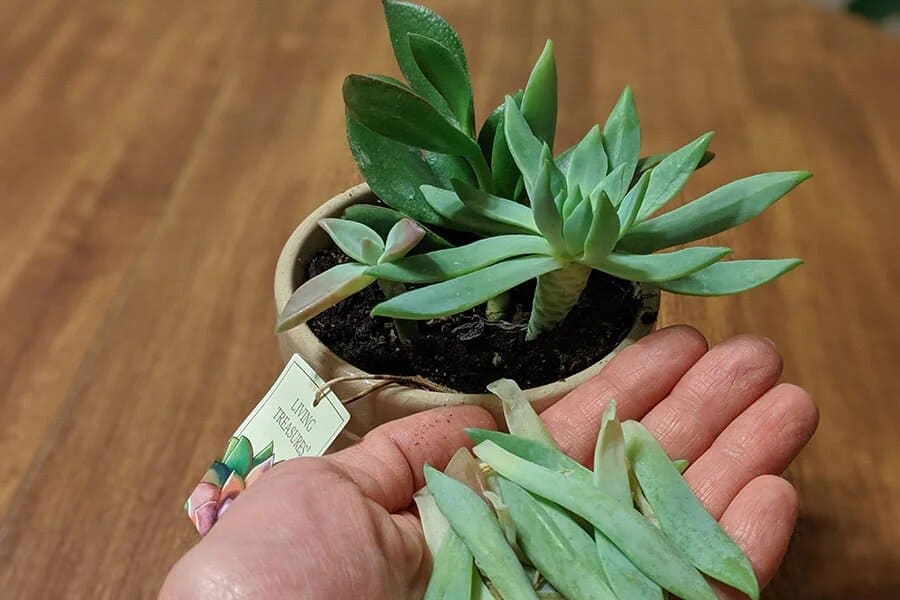
Contents
Succulent Leaves Falling Off
It’s not that hard to tell when your succulent is in distress. When it starts dropping leaves all over, you know it’s not happy. But it’s not as straightforward to figure out why your succulents are in trouble.
If you notice leaves falling off succulents and are unsure of what to do, don’t worry. In most cases, you can easily nurse your plant back to health; you just need to identify the cause of the problem to be able to solve it.
Leaves falling off succulents is a natural part of the growth process or a response to environmental stress, which may include circumstances such as:
- a need for a reduction in energy needs
- too much or too little water
- too little light
- chemical shock
- extreme heat
- extreme cold
… and more.
Succulent Healthcare Checklist
Here’s a succulent healthcare checklist to diagnose the cause of leaves falling off succulents:
- Find out if it is a normal behavior of losing the leaves or an extreme falling off.
- Are the leaves transparent, yellow and squishy?
- Are the leaves falling off from the top or bottom of the succulents?
- Is the soil damp most of the time?
- Is the soil specially prepared for the succulents?
- Is the soil compacted and holding the water?
- Does the succulent pot have drainage holes?
Causes for Leaves Falling Off Succulents
1. A Need for Reduction in Energy Needs
Symptom: Lower succulent leaves turning brown and crispy
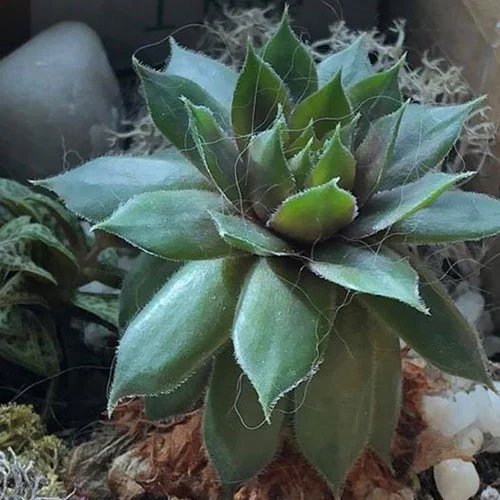
People often panic when they see leaves falling off succulents, especially if they don’t have a lot of experience with succulents. But are you aware that most houseplants naturally drop their bottom leaves as they grow?
Those leaves have lost their purpose, as they are now covered by higher leaves near the top of the plant. If it is only occasionally losing bottom leaves, there is actually no reason to worry.
What to do:
This is a natural phenomenon whereby the plant tends to absorb as much energy from its leaves as possible before shedding them. So you can ignore them until they drop naturally, or if you find this unsightly, simply remove the browned leaves carefully.
2. Too Much Water
Symptom: Succulent leaves turning soft, translucent and yellowish
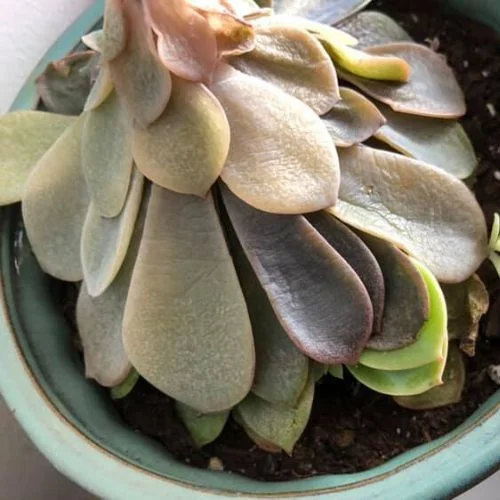
This is somewhat confusing because an underwatered succulent leaf can also seem slightly soft and squishy. The yellow coloration on the leaves is a dead giveaway, though, as are signs of root rot when you lift the plant out of its pot.
Succulents are known for low watering needs, and although too little will cause them to weaken and wilt, you must be careful to avoid overwatering them. Watering succulents too much too often can swell their leaves and, consequently, cause them to fall off the plant. The proper way to water succulents is to wait until the soil is almost dry and the leaves look a little wrinkled before doing so. Then water thoroughly, until you see the excess water coming out of the pot’s drainage holes. Therefore, always use pots with drainage holes when growing succulents.
Overwatering can have some serious consequences for your plant. It can cause root rot, making leaves fall off succulents, and can even cause total plant death! We’re not kidding when we say that over-watering is the number one cause of death for succulents, as the excess water causes the succulent’s cell walls to swell up.
You should only water your succulents when the soil it’s planted in is completely dry to the touch. You’ll probably end up watering your succulents once every week or two.
What to do:
Remove all affected leaves of the over-watered succulent. Check if the stem has rotted, and if so, cut off the rotted area and keep the healthy portion of the plant in a dry area for a week. Do not water the plant anymore during this time.
Re-pot the healthy portion of the plant after a week and follow a proper watering schedule henceforth. Drainage is crucial for succulents, so it’s a good idea to plant them in a gritty soil mix (like the ones here) and a pot with drainage holes at the bottom.
Read also:
Succulent leaves splitting: Why it happens and how to prevent It
Leaves falling off Christmas cactus? Here’s why
Bear paw succulent leaves falling off
3. Too Little Water
Symptom: Succulent leaves are wrinkled and shrunken
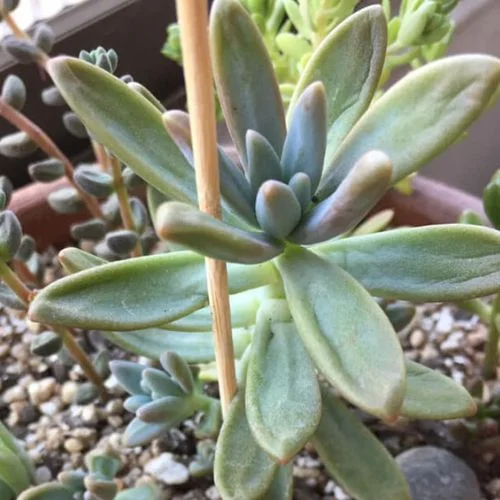
Even though succulent leaves falling off is commonly associated with overwatering, underwatering will also cause the same. If you leave your outdoor succulents without water for many days, you may find them looking weak and starting to wilt.
An underwatered succulent is easily identified by its soft and shrivelled leaves. Unlike overwatered leaves, not much change in color can be seen. The leaves will drop off at the slightest touch, and those which are too far gone will not recover despite the succulent being watered.
What to do:
Unless your succulent had been severely underwatered, it can usually be resuscitated. Just increase your watering frequency slightly–not too much–and your succulents will soon be happier.
4. Too Little Light
Symptom: Overall straggly succulent, new leaves growing smaller in size
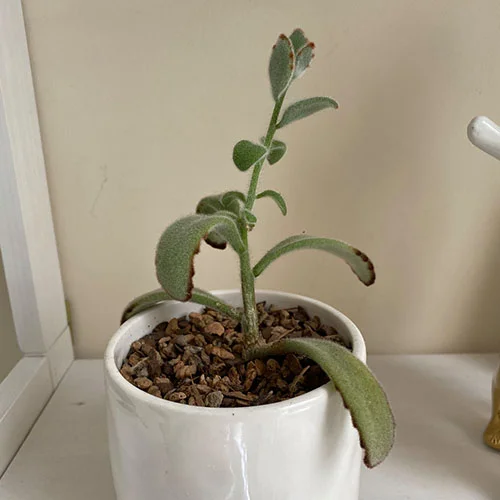
Succulents can start to drop their leaves if they’re kept in low light conditions for too long. Succulents need a good amount of light, especially as they are naturally adapted to habitats with lots of sun all year long. They love brightly lit areas, and when not given enough light, will turn yellow and straggly, trying to reach towards the light source. New leaves will also tend to grow smaller in size. If the issue is not resolved, they will eventually shed leaves.
What to do:
Luckily, this issue is very easy to fix! Just place your plant someplace sunnier, or under a grow light like this one—for additional grow lights we recommend, check out our article, here!
But before you put your succulent outside and expose it to the sun’s scorching heat, make sure to acclimate it first. Succulents can get sunburned too!
To acclimate your succulent for the outdoors, you should only expose it to about three hours of sunlight (avoid the afternoon sun) or artificial light daily. Anything more and you’ll risk sun-burning it. Then, gradually increase the duration of sun exposure over a few weeks until it is getting around five to six hours of bright sunlight each day, or around 12 hours of artificial light.
5. Chemical Shock
Symptom: Limp, wilted, crinkled, brittle, or very small leaves and stems
Shocking a succulent’s system can also cause its leaves to drop. When succulents contract fungal infections or diseases, it is certainly tempting to react immediately and excessively, but you must exercise caution. When using any chemical, always follow the package directions and do not apply more than what’s recommended. Also, always make sure your succulent isn’t already environmentally-stressed before you apply the chemicals.
If you apply too much fertilizer on your succulent, it could actually stunt its growth instead of promoting it. Some of your succulent’s leaves may also fall off, others discolored, and the root system burned.
What to do:
If you see any white crystals on the soil’s surface, this is leftover salt from the fertilizer which can burn your plant if left there. Don’t worry, most over-fertilized plants can be saved by a few simple steps. Remove visible fertilizer from the plant and soil, and leach away the fertilizer by allowing water to run through the roots. Then, remove damaged foliage and wait about a month before feeding your plant again.
In the future, remember to only feed your succulents with a water-soluble fertilizer, which has been diluted to half-strength. You should also feed them sparingly—no more than once a month during their growth phase. This way they won’t get overloaded with nutrients and start dropping leaves.
6. Extreme Heat
Symptom: Wilted leaves that may or may not have turned a shade of red or orange
Most succulents grow in naturally harsh habitats where they get exposed to intense sunlight with little surrounding plants to provide shade. This doesn’t mean they’re indestructible, however.
A sunny, enclosed area like a windowsill or patio can reach scorching temperatures in the summer, leaving your succulents to suffer. This is particularly an issue if the succulent is new and hasn’t been acclimatised to such a hot environment yet.
Since most succulents originate from hot, arid areas where extended periods of heat is a normal occurence, they respond by shedding leaves when stressed by drought or heat. Even though this is perfectly normal, keeping succulents in the shade when temperatures rise will help prevent this.
What to do:
Watch them closely: the leaves fall off easily when touched. If they look wilted or sunburned, either move them or place a shade cloth over them.
7. Extreme Cold
Symptom: Succulent leaves drooping and turning black before dropping
Most succulents can’t handle extreme cold, and if they’re exposed to freezing temperatures for too long, the cells inside their leaves can freeze, causing irreversible damage.
If your succulent has frozen in the winter, its leaves will look either brown or black and somewhat mushy. If the frost damage is really bad, the entire plant will look rotten. In such a case, it is pretty much unsalvageable.
But if only a few leaves here or there had suffered from frost damage, your succulent will recover. Sometimes these will drop off, but usually by then the plant has grown new leaves to replace them, so avoid peeling off these protective dead leaves.
What to do:
Since the damage has been done, all that’s left to do now is try to control it.
For a start, move the plant to a more enclosed location that isn’t too significantly different in temperature. From outdoors to a garage is a good choice: from outdoors to a warm place like indoors is often too extreme.
If you need to keep your succulents outdoors during winter, keep in mind that watering should be absolutely avoided. If wet, the soil will freeze causing damage to the roots. The succulents have the best chance of survival when kept bone dry.
Roy Cohen from Hack My Garage says: “Depending on where you live, your garage may get too hot or cold during the extreme months. Since some succulents may die between 30 and 40 degrees, it might make sense to invest in a 120v electric garage heater if you decide to store them in your garage for the winter.
Conclusion
Those are some of the potential causes of succulent leaf drops and how to resolve them. Did this article help you figure out why your succulent leaves are dropping?
Seeing your succulent leaves falling around in the pot is alarming, but many times, the plant can be rescued by making adjustments in its care. Observe the fallen leaves and compare them with the symptoms listed in this article to figure out what went wrong. Just don’t make any drastic changes: slow and steady is the way when it comes to caring for succulents!
Pro Tip:
A succulent leaf knocked off the mother plant is not necessarily lost. Succulents are very hardy, and lost leaves can sometimes still be propagated.
